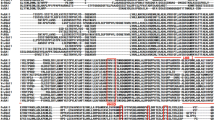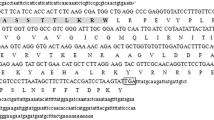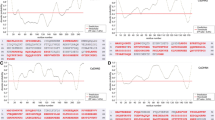Abstract
Leafy spurge (Euphorbia esula) is a perennial weed which is capable of acclimating to sub-freezing temperatures. We have used the differential display technique to identify and clone a cDNA for a cold-regulated gene (cor20) which hybridizes to mRNAs that accumulate specifically during the cold acclamation process. The cor20 cDNA was used to isolate two different genomic clones. Both clones were similar but not identical to each other and the cDNA. Sequence analysis of the genomic clones indicated that they share considerable homology to a group of glycine-rich RNA-binding protein genes. Comparison of the promoter region from the three clones (Ccr1 from Arabidopsis, BnGRP1O from Brassica napus, and GRRBP2 from Euphorbia esula) have identified at least two conserved motifs. CAGC is most likely involved in cold regulation and AACCCYAGTTA, is conserved but has no known function. RNAs which hybridize to cor20 reach maximal expression in less than 2 days after exposure of the plant to temperatures of 5 °C , and remains at high levels in the plant for at least 30 days so long as the plant is left in the cold. These RNAs drop to control levels within 24 h when the plant is returned to normal growing temperatures. Transcripts which hybridize to cor20 do not accumulate under conditions of drought or heat stress. These transcripts are induced in response to low temperatures in roots, stems and leaves, but are expressed constitutively in tissue culture at control temperatures.
Similar content being viewed by others
References
Bergeron D, Beauseigle D, Bellemare G: Sequence and expression of a gene encoding a protein with RNA-binding and glycine-rich domains in Brassica napus. Biochim Biophys Acta 1216: 123–125 (1993).
Carpenter CD, Krebs JA, Simon AE: Genes encoding glycinerich Arabidopsis thaliana proteins with RNA-binding motifs are influenced by cold treatment and an endogenous circadian rhythm. Plant Physiol 104: 1015–1025 (1994).
Didierjean L, Frendo P, Burkard G: Stress response in maize: sequence analysis of cDNAs encoding glycine-rich proteins. Plant Mol Biol 18: 847–849 (1992).
Dunn MA, Goddard NJ, Zhang L, Pearce RS, Hughes MA: A low-temperature responsive gene from barley encodes a protein with single stranded nucleic acid binding activity which is phosphorylated in vitro. Plant Mol Biol 30: 947–959 (1996).
Galitz, DS: The biology of leafy spurge. Proceedings of the Leafy Spurge Strategic Planning Workshop, March 29- 30. Dickinson, ND (1994).
Gordan-Kamm WJ, Steponkas P: The influence of cold acclamation on the behavior of the plasma membrane following osmotic contraction of isolated protoplasts. Protoplasms 123: 161–173 (1984).
Hajela RK, Horvath DP, Gilmour SJ, Thomashow MF: Molecular cloning and expression of cor (cold-regulated) genes in Arabidopsis thaliana. Plant Physiol 93: 1246–1252 (1990).
Heintzen C, Melzer S, Fischer R Kappeler S, Apel K, Staiger D: A light-and temperature-entrained circadian clock controls expression of transcripts encoding nuclear proteins with homology to RNA-binding proteins in meristematic tissues. Plant J 5: 799–813 (1994).
Hirose T, Carrol KL, Masson PH: Molecular characterization of PAB2, a member of the multigene family coding for poly(A)-binding proteins in Arabidopsis thaliana. Plant Physiol 103: 525–533 (1993).
Horvath DP: Cloning, characterization, and regulation of four cold-induced genes from Arabidopsis thaliana. Graduate thesis, Michigan State University, East Lansing, MI (1993).
Hughes MA, Dunn MA: The molecular biology of plant acclamation to low temperature. J Exp Bot 47: 291–305 (1996).
Jarillo JA, Capel J, Leyva A, Miguel J, Martinez-Zapater JM, Salinas J: Two related low-temperature-inducible genes of Arabidopsis encode proteins showing high homology to 14–3–3 proteins, a family of putative kinase regulators. Plant Mol Biol 25: 693–704 (1994).
Levit J: Response of Plants to Environmental Stress: Chilling, Freezing, and High Temperature Stresses, Academic Press, New York (1980).
Ludevid MD, Frejre MA, Gó mez J, Burd CG, Alberico F, Giralt E, Dreyfuss G, Pagés M: RNA binding characteristics of a 16 kDa glycine-rich protein from maize. Plant J 2: 990–1003 (1992).
Noble DL, Duan PH, Andres LA: The leafy spurge problem. Proceedings of the Leafy Spurge Symposium, pp. 8–15. North Dakota Co-operative Extension Service, Fargo, ND (1979).
Nordin K, Heino P, Palva ET: Differential expression of two related low-temperature-induced genes in Arabidopsis thaliana. Plant Mol Biol 21: 641–653 (1993).
Orr W, Lu B, White TC, Robert LS, Singh J: Complementary DNA sequence of a low-temperature-induced Brassica napus gene with homology to the Arabidopsis thaliana kin1 gene. Plant Physiol 98: 1532–1534 (1992).
Sáez-Vásqueze J, Raynal M, Meza-Basso T, Delsney M: Two related low-temperature-induced genes from Brassica napus are homologous to the human tumor bbc1 (breast basic conserved) gene. Plant Mol Biol 23: 1211–1221 (1993).
Sambrook J, Fritsch EF, Maniatis T: Molecular Cloning: A Laboratory Manual, 2nd ed. Cold Spring Harbor Laboratory Press, Cold Spring Harbor, NY (1989).
Sakai A, Larcher W: Frost Survival of Plants: Responses and Adaptations to Freezing Stress. Springer-Verlag, Berlin (1987).
Schultz DJ, Craig R, Cox-Foster DL, Mumma RO, Medford JI: RNA isolation from recalcitrant plant tissue. Plant Mol Biol 12: 310–316 (1994).
Steponkas PL, Lynch DV: Freeze/thaw-induced destabilization of the plasma membrane and the effects of cold acclimation. J Bioenerg Biomembr 21: 21–41 (1989).
Stockinger EJ, Gilmour SJ, Thomashow MF: Arabidopsis thaliana CBF1 encodes an AP2 domain-containing transcriptional activator that binds to the C-repeat/DRE, a cis-acting DNA regulatory element that stimulates transcription in re sponse to low temperature and water deficit. Proc Natl Acad Sci USA 94: 1035–1040 (1997).
Sturm A: A wound-inducible glycine-rich protein from Daucus carota with homology to single-stranded nucleic acidbinding proteins. Plant Physiol 99: 1689–1692 (1992).
Weretilnyk E, Orr W, White TC, Lu B, Singh J: Characterization of three related low-temperature-regulated cDNAs from winter Brassica napus. Plant Physiol 101: 171–177 (1993).
White TC, Sinimonds D, Donaldson P, Singh J: Regulation of BN 115, a low-temperature-responsive gene from winter Brassica napus. Plant Physiol 106: 917–928 (1994).
Wilhelm KS, Thomashow MF: Arabidopsis thaliana cor15b, an apparent homologue of cor15a, is strongly responsive to cold and ABA, but not drought. Plant Mol Biol 23: 1073–1077.
Yamaguchi-Shinozaki K, Shinozaki K: Characterization of the expression of a desiccation-responsive rd29 gene of Arabidopsis thaliana and analysis of its promoter in transgenic plants. Mol Gen Genet 236: 331–340 (1993).
Yamaguchi-Shinozaki K, Shinozaki K: A novel cis acting element in an Arabidopsis gene is involved in responsiveness to drought, low-temperature, or high-salt stress. Plant Cell 6: 251–264 (1994).
Author information
Authors and Affiliations
Rights and permissions
About this article
Cite this article
Horvath, D.P., Olson, P.A. Cloning and characterization of cold-regulated glycine-rich RNA-binding protein genes from leafy spurge (Euphorbia esula L.) and comparison to heterologous genomic clones. Plant Mol Biol 38, 531–538 (1998). https://doi.org/10.1023/A:1006050208670
Issue Date:
DOI: https://doi.org/10.1023/A:1006050208670




